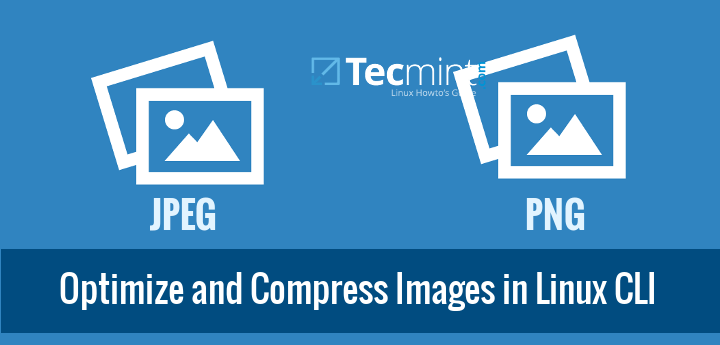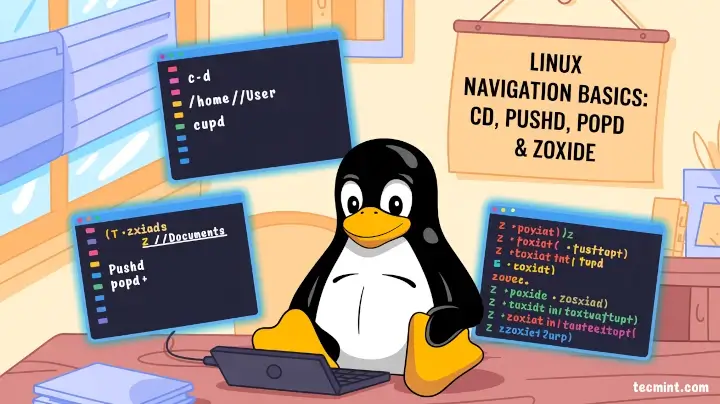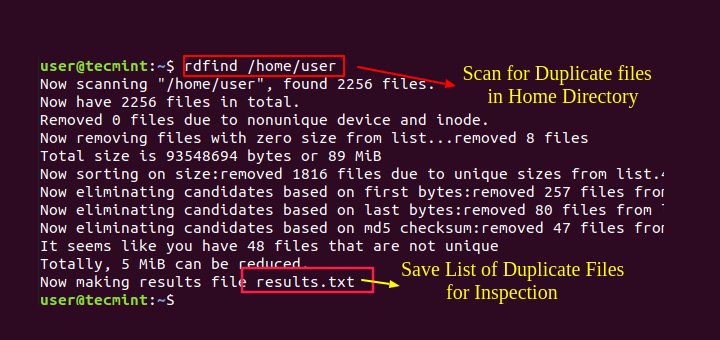You have a lot of images, and want to optimize and compress the images without losing its original quality before uploading them to any cloud or local storages? There are plenty of GUI applications available which will help you to optimize the images. However, here are two simple command line utilities to optimize images and they are:
- jpegoptim – is a utility to optimize/compress JPEG files without loosing quality.
- OptiPNG – is a small program that optimize PNG images to smaller size without losing any information.

Using these two tools, you can either optimize a single or multiple images at a time.
Compress or Optimize JPEG Images from Command Line
jpegoptim is a command line tool that can be used to optimize and compress JPEG, JPG and JFIF files without losing its actual quality. This tool supports lossless optimization, which is based on optimizing the Huffman tables.
Install jpegoptim in Linux
To install jpegoptim on your Linux systems, run the following command from your terminal.
On Debian and it’s Derivatives
# apt-get install jpegoptim or $ sudo apt-get install jpegoptim
On RedHat based Systems
On RPM based systems like RHEL, CentOS, Fedora etc., you need to install and enable EPEL repository or alternatively, you can install the epel repository directly from the commandline as shown:
# yum install epel-release # dnf install epel-release [On Fedora 22+ versions]
Next install jpegoptim program from the repository as shown:
# yum install jpegoptim # dnf install jpegoptim [On Fedora 22+ versions]
How to Use Jpegoptim Image Optimizer
The syntax of jpegoptm is:
$ jpegoptim filename.jpeg $ jpegoptim [options] filename.jpeg
Let’s now compress the following tecmint.jpeg image, but before optimizing the image, first find out the actual size of the image using du command as shown.
$ du -sh tecmint.jpeg 6.2M tecmint.jpeg
Here the actual file size is 6.2MB, now compress this file by running:
$ jpegoptim tecmint.jpeg

Open the compressed image in any image viewer application, you will not find any major differences. The source and compressed images will have the same quality.
The above command optimizes the images to the maximum possible size. However, you can compress the given image to a specific size to, but it disables the lossless optimization.
For example, let us compress above the image from 5.6MB to around 250k.
$ jpegoptim --size=250k tecmint.jpeg

Batch JPEG Image Compression and Optimization
You might ask how to compress the images in the entire directory, that’s not difficult too. Go to the directory where you have the images.
tecmint@tecmint ~ $ cd img/ tecmint@tecmint ~/img $ ls -l total 65184 -rwxr----- 1 tecmint tecmint 6680532 Jan 19 12:21 DSC_0310.JPG -rwxr----- 1 tecmint tecmint 6846248 Jan 19 12:21 DSC_0311.JPG -rwxr----- 1 tecmint tecmint 7174430 Jan 19 12:21 DSC_0312.JPG -rwxr----- 1 tecmint tecmint 6514309 Jan 19 12:21 DSC_0313.JPG -rwxr----- 1 tecmint tecmint 6755589 Jan 19 12:21 DSC_0314.JPG -rwxr----- 1 tecmint tecmint 6789763 Jan 19 12:21 DSC_0315.JPG -rwxr----- 1 tecmint tecmint 6958387 Jan 19 12:21 DSC_0316.JPG -rwxr----- 1 tecmint tecmint 6463855 Jan 19 12:21 DSC_0317.JPG -rwxr----- 1 tecmint tecmint 6614855 Jan 19 12:21 DSC_0318.JPG -rwxr----- 1 tecmint tecmint 5931738 Jan 19 12:21 DSC_0319.JPG
And then run the following command to compress all images at once.
tecmint@tecmint ~/img $ jpegoptim *.JPG DSC_0310.JPG 6000x4000 24bit N Exif [OK] 6680532 --> 5987094 bytes (10.38%), optimized. DSC_0311.JPG 6000x4000 24bit N Exif [OK] 6846248 --> 6167842 bytes (9.91%), optimized. DSC_0312.JPG 6000x4000 24bit N Exif [OK] 7174430 --> 6536500 bytes (8.89%), optimized. DSC_0313.JPG 6000x4000 24bit N Exif [OK] 6514309 --> 5909840 bytes (9.28%), optimized. DSC_0314.JPG 6000x4000 24bit N Exif [OK] 6755589 --> 6144165 bytes (9.05%), optimized. DSC_0315.JPG 6000x4000 24bit N Exif [OK] 6789763 --> 6090645 bytes (10.30%), optimized. DSC_0316.JPG 6000x4000 24bit N Exif [OK] 6958387 --> 6354320 bytes (8.68%), optimized. DSC_0317.JPG 6000x4000 24bit N Exif [OK] 6463855 --> 5909298 bytes (8.58%), optimized. DSC_0318.JPG 6000x4000 24bit N Exif [OK] 6614855 --> 6016006 bytes (9.05%), optimized. DSC_0319.JPG 6000x4000 24bit N Exif [OK] 5931738 --> 5337023 bytes (10.03%), optimized.
You can also compress multiple selected images at once:
$ jpegoptim DSC_0310.JPG DSC_0311.JPG DSC_0312.JPG DSC_0310.JPG 6000x4000 24bit N Exif [OK] 6680532 --> 5987094 bytes (10.38%), optimized. DSC_0311.JPG 6000x4000 24bit N Exif [OK] 6846248 --> 6167842 bytes (9.91%), optimized. DSC_0312.JPG 6000x4000 24bit N Exif [OK] 7174430 --> 6536500 bytes (8.89%), optimized.
For more details about jpegoptim tool, check out the man pages.
$ man jpegoptim
Compress or Optimize PNG Images from Command Line
OptiPNG is a command line tool used to optimize and compress PNG (portable network graphics) files without losing its original quality.
The installation and usage of OptiPNG is very similar to jpegoptim.
Install OptiPNG in Linux
To install OptiPNG on your Linux systems, run the following command from your terminal.
On Debian and it’s Derivatives
# apt-get install optipng or $ sudo apt-get install optipng
On RedHat based Systems
# yum install optipng # dnf install optipng [On Fedora 22+ versions]
Note: You must have epel repository enabled on your RHEL/CentOS based systems to install optipng program.
How to Use OptiPNG Image Optimizer
The general syntax of optipng is:
$ optipng filename.png $ optipng [options] filename.png
Let us compress the tecmint.png image, but before optimizing, first check the actual size of the image as shown:
tecmint@tecmint ~/img $ ls -lh tecmint.png -rw------- 1 tecmint tecmint 350K Jan 19 12:54 tecmint.png
Here the actual file size of above image is 350K, now compress this file by running:
tecmint@tecmint ~/img $ optipng tecmint.png
OptiPNG 0.6.4: Advanced PNG optimizer.
Copyright (C) 2001-2010 Cosmin Truta.
** Processing: tecmint.png
1493x914 pixels, 4x8 bits/pixel, RGB+alpha
Reducing image to 3x8 bits/pixel, RGB
Input IDAT size = 357525 bytes
Input file size = 358098 bytes
Trying:
zc = 9 zm = 8 zs = 0 f = 0 IDAT size = 249211
Selecting parameters:
zc = 9 zm = 8 zs = 0 f = 0 IDAT size = 249211
Output IDAT size = 249211 bytes (108314 bytes decrease)
Output file size = 249268 bytes (108830 bytes = 30.39% decrease)
As you see in the above output, the size of the tecmint.png file has been reduced up to 30.39%. Now verify the file size again using:
tecmint@tecmint ~/img $ ls -lh tecmint.png -rw-r--r-- 1 tecmint tecmint 244K Jan 19 12:56 tecmint.png
Open the compressed image in any image viewer application, you will not find any major differences between the original and compressed files. The source and compressed images will have the same quality.
Batch PNG Image Compression and Optimization
To compress batch or multiple PNG images at once, just go the directory where all images resides and run the following command to compress.
tecmint@tecmint ~ $ cd img/
tecmint@tecmint ~/img $ optipng *.png
OptiPNG 0.6.4: Advanced PNG optimizer.
Copyright (C) 2001-2010 Cosmin Truta.
** Processing: Debian-8.png
720x345 pixels, 3x8 bits/pixel, RGB
Input IDAT size = 95151 bytes
Input file size = 95429 bytes
Trying:
zc = 9 zm = 8 zs = 0 f = 0 IDAT size = 81388
Selecting parameters:
zc = 9 zm = 8 zs = 0 f = 0 IDAT size = 81388
Output IDAT size = 81388 bytes (13763 bytes decrease)
Output file size = 81642 bytes (13787 bytes = 14.45% decrease)
** Processing: Fedora-22.png
720x345 pixels, 4x8 bits/pixel, RGB+alpha
Reducing image to 3x8 bits/pixel, RGB
Input IDAT size = 259678 bytes
Input file size = 260053 bytes
Trying:
zc = 9 zm = 8 zs = 0 f = 5 IDAT size = 222479
zc = 9 zm = 8 zs = 1 f = 5 IDAT size = 220311
zc = 1 zm = 8 zs = 2 f = 5 IDAT size = 216744
Selecting parameters:
zc = 1 zm = 8 zs = 2 f = 5 IDAT size = 216744
Output IDAT size = 216744 bytes (42934 bytes decrease)
Output file size = 217035 bytes (43018 bytes = 16.54% decrease)
....
For more details about optipng check man pages.
$ man optipng
Conclusion
If you’re a webmaster and wants to serve optimized images over your website or a blog, these tools can be very handy. These tools not only saves the disk space, but also the reduces the bandwidth while uploading the images.
If you know any other better way to achieve same thing, do let us know via comments and don’t forget to share this article on your social networks and support us.







Does either of these optimization tools retain metadata embedded in the image? (such as Exif, etc)
Hey there! jpegoptim does not work with filenames that start with – (dash). It considers that you pass an argument and It fails. Does anybody knows an workaround for this situation? Thank you!
Wow. jpegoptim really fails to accept
"--"(double-dash) as ending sequence for parameters. With many binaries you can: `jpegoptim — -myfile.jpg` – But this fails silently.So Plan B could be: `jpegoptim –stdin –stdout > -output.jpg < -input.jpg`
This is a very nifty little app, but sadly I find the compressions to be minimal to say the least. On average with most of my images, it would only reduce the file size by about 3% whereas when i use something like ffmpeg or imagemagick I am able to compress those same files down by about 80%.
I actually experienced the opposite,
optipngdoes great, if you try to use ffmpeg the file gets 10x larger.Take a file, for example, image7.png and do the following:
Hello, may I ask?
How to specify the image compression level in png format
For example, 1-100. What should I do if I want to press the picture to 60%?
Copying your commands didn’t work for me/Arch Linux. Changing
*.JPGto*.jpgdid.However it only reduced the size about 3%, so I used
jpegoptim --size=750k *.jpg.The pics still look great on the screen. Thank you very much!
Very nice! Does the batch operation work recursively?
+ 1 for recursive please?
You can use the find command to recursively find all .jpeg and .jpg files and then pass them to jpegoptim, that should do it for you.
The command will look like this
# Jpegoptim
find images_folder/ *.{jpeg,jpg} -exec jpegoptim {} \;
# OptiPNG
find images_folder/ *.png -exec optipng {} \;
Replace `images_folder` with the path for whatever directory you have your files in
how folder with sub folder too?
command find will process all subfolders automatically
Hi,
this usage of `find` in conjunction with `jpegoptim` (and possibly also with `optipng`) will call the `jpegoptim` command for every file `find` matches.
In case anyone is looking for processing all matching files in a single run, try the following:
`find path/to/images/ -regex ".*\.\(jpg\|jpeg\)" -exec jpegoptim {} +`Note the
`+`at the end of the`exec`command, which leads to`exec`finally being called with all matching files.Source: https://www.booleanworld.com/guide-linux-find-command/ (right above “Executing commands on directories”)
Hi, how are you? Thanks so much for this. Made a bash script to run on my site’s image folder and it works well. Working on creating a cronjob for automation. Now I have a question. How can I do the same with GIFs, WEBP, and SVGs?
jpegoptim dir/**/*.jpgwhen I run the command I get something like this:
Type the following command:
Sample outputs:—-
Finally, I have been looking for such tools for image optimization on Linux. Until now, i have always required intenet for image optimizations. Thanks for the post.
Hello, just wanted to thank you for the article. I needed a way to optimize my images to pass google’s pagerank and this helped immensely. Once again thanks for the easy to read tutorial.
and there are two very interesting ideas to compress & optimize pictures by parallel execution & CUDA
hi,
many thanks for the very interesting article & discussions!
there is a very promising project:
https://github.com/mozilla/mozjpeg
This tutorial helped me a lot, one of sites I have to optimize it’s images for more faster loading, result now: https://gtmetrix.com/reports/aswakbladi.com/013Tow1p
It is better the doing it manually. For me I set those options for JPG images:
-s option will strip other information reside inside image, and also it will save you extra bandwidth and results in faster loading.
PNG images:
Just wondering if the target image is already optimized then will it be skipped?
@Masa,
I think it will try to optimize as much as it can, but will not skip for sure, give a try and see yourself.
okay. That is what I guessed….Well…thanks for reply.
Excellent! Must-try Linux tips. Thanks for sharing
I cannot open the pic after optimisation. Is it because the pic has only 63k?
@Vule,
Size doesn’t matter, you can optimize any size images from 10KB to 10MB, what error you getting while opening optimized image? which tool you used to view images? do you tried with different image viewers?
Hi! :-)
Take also a look, at Trimage.
G.
@Giorgos,
Thanks for the tip about Trimage tool, but we’re getting 404 error while accessing the page, seems no more development and also I found that the last update was 5 years ago on Github
I use ‘convert’
With a small script take all the files from ./orig and create thumbnails in ./pics and a larger picture in ./pics-big
it also creates the entries for the html file
it reduces the image to 28% and 64% of their original dimensions – but that is how my camera is set up
#!/bin/bash
cd orig;
for file in *; do convert -strip -scale 64%x64% -quality 75 $file “../pics-big/”$file;
convert -strip -scale 28%x28% -quality 75 $file “../pics/”$file;
echo ” ” >> ../html.txt;
done;
@Yavor,
Thanks a ton for sharing the script with us, I was looking for such script since long time for my camera images, which are huge in size..let me try and get back to you..
Hi,
Thanks a lot…
very useful article….
You’re welcome buddy.
with OptiPNG i was familiar with, so after reading your article, I gave a try to jpegoptim: it was useless for my final JPEGs, which are produced with GIMP, and are destined to web use – 0.00% improvement. on a batch of JPEGs taken straight from the camera, for the batch I tested, the average space savings was 2.36%
my conclusion: it would be useless for a webmaster trying to minimize bandwidth use, it wasn’t able to do a thing.
@Nicu,
I totally agree with your point that jpegoptim not a best tool for JPEG or JPG compression, it just reduce the size around 5-10% that’s totally useless to use, whereas OptinPNG works great it optimize images nearly 30-40% but still I can say it’s not a good choice to use for websites, where speed is more important. Even I tried different online jpeg or png compression tools, still not a good results specially for jpeg images…